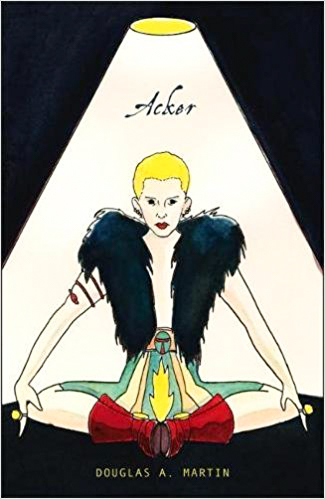
2017 was a fantastic year for Kathy Acker, the famous and infamous experimental-punk-poet-novelist-essayist-critic-intellectual who is perhaps most well known for brazenly reimagining (plagiarizing?) large swaths of canonical texts, depicting sexually subversive scenes and relationships, and espousing feminist and anti-capitalist politics in and through her works. Acker died from cancer in 1997, but her presence is still felt in postmodern literary, critical, and artistic circles. Chris Kraus, of “I Love Dick” celebrity, has published a handful of Acker’s collected zines, stories, conversations, and email correspondences via Semiotext(e), the uber-hip, art-inflected imprint that Kraus and Sylvère Lotringer have used to bring numerous brands and bands of critical theory and theorists into conversation with each other over the last few decades. Most recently, Kraus published “After Kathy Acker,” a literary biography of Acker that received much hype and, so far, a staggering total of four Amazon customer reviews (they’re very positive). With one fourth the Amazon reviews and one small fraction of the hype, University Visiting Writer in English Douglas Arthur Martin’s 2017 biography of Kathy Acker presents a rigorous, impassioned, expansive, intentionally inconclusive portrait of Acker.

Martin published “Acker” via Nightboat Books, which carefully describes the book as “a lyric essay written through Kathy Acker’s evocative prose, public statements, and private archives.” This description, while accurate, doesn’t say much about what “Acker” looks like: The book is divided into two parts. Each consists of a numbered list of paragraphs. Every paragraph is a portal, an opening, a thread, a doorway, a tunnel, or a hold on a climbing wall that you may or may not latch onto. Martin’s lists do not seek to enumerate, catalog, or order in any traditional sense. Sequential paragraphs occasionally connect in a linear way, but more often than not Martin lets paragraphs accumulate in a casual, association-based fashion that belies the ambitious archival research that informs and inspires this book. Somehow Martin’s paragraphs feel accrued, like he picked them up from a shore where they had been washed up, numbering them as he went. This isn’t to say that the numbered list form of the essay feels arbitrary—quite the opposite. The numbered list form helps structure a work that is exploding with movement.
Martin’s first set of movements concerns Acker’s birth, which seems a reasonable starting position for a capital-B Biographer. But Martin is not a capital-B Biographer. He quickly challenges formal conventions by refusing to make a declarative statement about when Acker was born, which reflects both Acker’s long-cultivated biographical mystique and Martin’s curious modes of framing, tracing, and outlining, which, like Acker’s own work, pointedly de-emphasize the discrete, the knowable, and the stable. Other key themes that Acker and Martin explore together include familial and sexual relations; memory; dreams; authorship; compositional techniques; reading and translation; and the economic, social, and political conditions that organize (or might organize) the movements of texts and bodies, which are almost interchangeable concepts for both Martin and Acker.
Acker deftly interrogates the ways in which dominant ideologies, institutions, and writing and reading practices limit, contain, constrain, dictate, legislate, or otherwise narrate the interaction of bodies—textual, corporeal, intellectual, sexual, and so on. Much of Acker’s work resisted these culturally and legally imposed limits, and it is a great credit to Martin that he channels, reenacts, and performs her resistances through and across her archives. He does this while engaging feminist scholarship, queer theory, French literary theory, psychoanalytic theory, object relations theory, and other intellectual frameworks, political movements, and poetic schools. Martin places Acker in conversation with Marquis de Sade, William S. Burroughs, Jean Genet, Marcel Duchamp, Gertrude Stein, Antonin Artaud, and Andy Warhol. Martin reads with Sigmund Freud, Roland Barthes, Jacques Lacan, Michel Foucault, Cindy Sherman, Sherrie Levine, Richard Prince, Jenny Holzer, Arthur Rimbaud, Charles Baudelaire, Susan Sontag, Herbert Marcuse, Gilles Deleuze, Félix Guattari, Melanie Klein, Guy Hocquenghem, Hannah Arendt, Samuel R. Delany, Marguerite Duras, the Beats, and the New York School, often listening for the ways that these artists’, writers’, and thinkers’ tunes and tones may have harmonized for and in Acker’s many bodies.
Martin, also a poet and novelist, writes long, sensual sentences that exaggerate his own affection for the improvisational, association-based writing and editing techniques that Acker embraced.
The following quote, attributed to Acker, could just as easily describe the frenetic, dynamic quality of Martin’s sentences: “I guess I just want to go on a journey and so I start with a sentence and then the language twists and turns and you don’t even remember where you’ve been, you’re just faced with the present.” Note the twists and turns in the following sentences: “Composed of the works of others, the Acker ‘Great Expectations’ book would signal turns, showcase, fan out other authors within her sentences from theirs. For angled purposes of transport, the word, the book, is made more untransparent, becoming something else as progeny, as the material of the previous books is made anew in some current medium.” (Side note: What a beautiful description of that thing that most people call plagiarism!)
For both Acker and Martin, a single sentence can move in multiple directions. Nothing is singular if you’re properly attuned to plurality.
Martin is especially adept at performing the bodily/textual entanglements that stimulate Acker: “I’m beginning to disintegrate,” Acker writes, as “Red” gets more and more wrapped up in its own rhythms: “I try to imagine my mother,” “my whole shudders,” “I become nothing I become whatever happens to pass through me.”
Similarly, when reading Acker at times, I feel. Towards the end of this scene, age, chapter: “I love my mother. RED: we separate our bodies and she leaves.”
We move into and out of Acker, into and out of Martin, between Martin and Acker, through Acker and Martin, and across Acker and Martin.
Another example: “Acker maps dreams out. Dreams tattoo imagination, and with her tattoos, Acker maps her body.”
Here, again, we see a confusion of bodies, both textual and corporeal, that performs the type of entanglement that both Acker and Martin are so intent on practicing, following, dreaming, and mapping.
Martin quotes, references, and excerpts numerous Acker books: “Don Quixote, which was a Dream”; “Blood and Guts in High School”; “Empire of the Senseless”; “Great Expectations; Literal Madness (Kathy Goes to Haiti; My Death My Life by Pier Paolo Pasolini; Florida)”; “In memoriam to identity”; “Portrait of an Eye: The Childlike Life of the Black Tarantula by the Black Tarantula”; “I Dreamt I Was a Nymphomaniac! Imagining”; “The Adult Life of Toulouse Lautrec by Henri Toulouse Lautrec”; “My Mother: Demonology; Pussy, King of the Pirates”; “Bodies of Work: Essays”; “Eurydice in the Underworld”; and “Rip-off Red, Girl Detective and the Burning Bombing of America: The Destruction of the U.S.” These texts spanned from 1986 to 2002, but in Martin’s hands, they become one body, united by modes of looking and making that prioritize restlessness and experimentation.
Not even the narrators of Acker’s novels can avoid her characteristic sense of flux.
“An I: the idea of any stable identity becomes for Acker the field to derange or rearrange, the constituent points and poles of which can and might be moved and refigured, for a number of pages,” Martin writes.
Martin’s portrait of Acker is densely layered, intellectually and formally challenging, and stunningly beautiful. “Acker” is a testament to the ways in which Kathy Acker made work and worked, as well as to the ways in which her many textual bodies continue to work.
“In her last novel, Pussy, King of the Pirates (1996),” Martin writes, “Acker pries the caste of Robert Louis Stevenson’s ‘Treasure Island’ open, and inserts girls right there along with the pirates, girls now too, working through her writing anarchic plundering, re-figuring, re-sourcing goods: planting girls everywhere. Literary heresy, perhaps, and textual sorcery is not to be dismissed.”
Martin’s textual sorcery, like Acker’s, is not to be dismissed.
Matt Wallock can be reached at mwallock@wesleyan.edu.



Leave a Reply